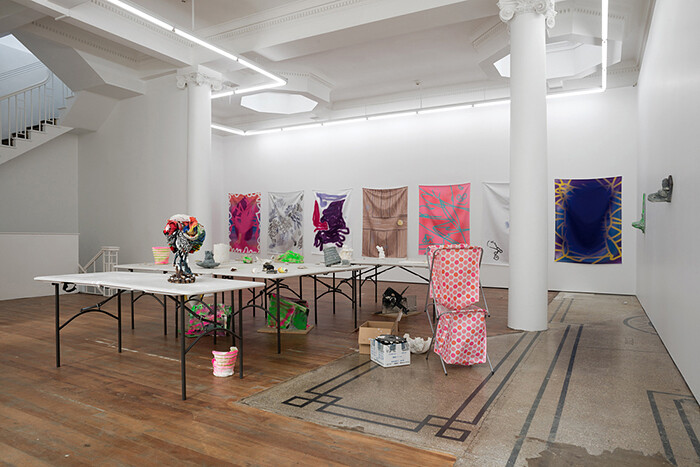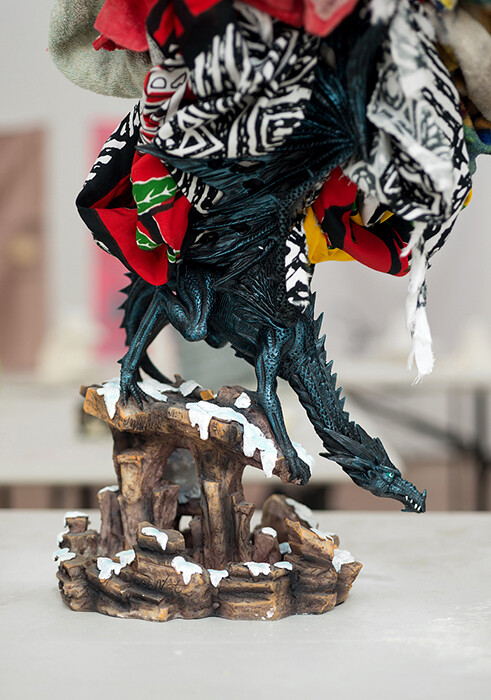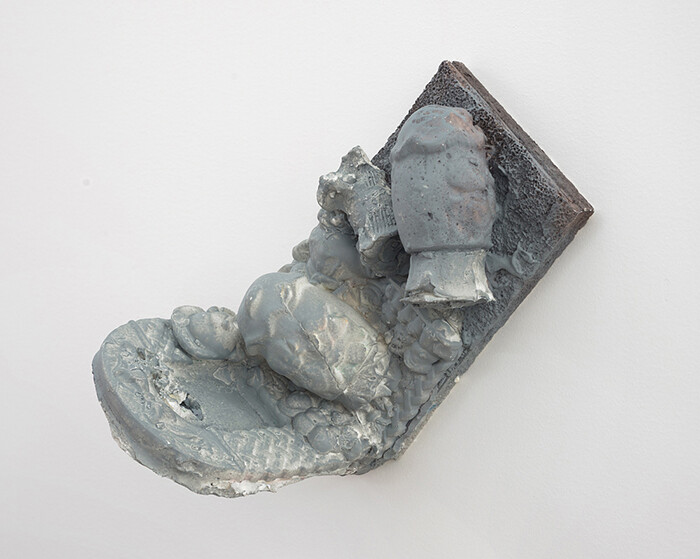As its title suggests, “Plastic Mouthfeel II,” the latest exhibition from New Zealand artist Dan Arps, is a space full of viscous forms, loaded with colors and textures, that causes a constant sense of elastic deformation. Take, for example, Studio Units with Double Hamper (2015), a set of five white but unclean folding trestle tables, located at the center of the gallery, on top of and around which an uncustomary arrangement of disparate objects and detritus invites careful examination. Spread out on the tables and the surrounding floor—as the landscape of a work in progress, such as those found in art schools—are casts, brightly tinted pots, splashed paint, clay chunks, multicolored Abstract Expressionist sculptures, melted assemblages, boxes, and a pink polka-dot double hamper. Some pieces of the installation are particularly comical, such as a small, white, psychedelic sculpture of a piggy bank on a mushroom, and a readymade with a dragon figure carrying on its back a rolled-up dirty towel. But this thoughtful mess seems not meant for display or public consumption. While trying to scrutinize the content of a carton on the floor, one gets the uncanny sensation of poking around someone’s stuff. Evoking the spirit of a workshop inside a gallery, Arps’s effective meta-space induces a feeling of being simultaneously a wanted art viewer and an unwelcome trespasser, a bipolar effect that is characteristic of the artist’s work.
These sensations dissipated somewhat when I noticed works on an adjoining wall, more conventionally arranged for exhibition: three polyurethane-based interstices of sculpture and painting whose seductive textures call to be touched. For instance, Relief Study (Fluro/Primer) (2014) consists of formless reliefs, resembling plasticine squeezed and kneaded. Its gray undercoat, suffused with fluorescent pink, makes the volume of these reliefs even more striking. Arps’s work shows an interest in workplaces and pathologies; perhaps here is another psychological turn, a parallel between art and therapy implied in the title. Aside, thoughtfully installed at a 45-degree angle, is Untitled (Primer Series) (2014), another transformation of mundane, infantile objects into intriguing, polysemous, and indecipherable matter, which, depending on the position of the viewer, could resemble a pot fountain or a tomb. In the corner is Lump (Silver/Fluro) (2014), a melted clump protruding through the bottom of a flat, rectangular surface painted in silver and with toxic fluorescent green tinges.
This scenographic arrangement continues with a series of nine multilayered and multicolored dye-sublimation prints on satin—a process commonly used in mass textile production—lining the far walls of the gallery. Personal favorites are Leveled Up (Pikachu) and Pen Testing (both 2015). The former is a print of pen drawings that juxtaposes, on the background, a pair of tic-tac-toe games and studs. In the foreground, a pair of Pikachus ironically show their competitive nature, transforming their cute and infantile anatomies into monstrous faces and ridiculous, super muscular bodies. The latter consists of a series of different pen marks that create a pleasing abstract composition in gray, blue, and black. Both works are simple and effective; they have a sense of casualness that permeates Arps’s work.
“Plastic Mouthfeel II” is an intimate experience of a complex ensemble, which continues the artist’s explorations of the nature of ordinary consumer objects, emotions, psychology, and everyday life through the site-specific practice of staging spaces-within-spaces. This use of space is maybe the most remarkable aspect of the show, as it positions visitors as the potential protagonists of a number of distinct narratives: the exhibition relies on the structure of the commercial gallery; practically it is a closed space for immersion among objects; and it operates as a fictional school. This intersection draws a Borromean knot that interlinks the three rings of today’s system of artistic production—education, display, and the market. Through the careful exposition of intriguing objects, this spatial interplay also creates different phenomenological effects, inducing a sense of mystery, inspection, and wonder in participants. As reflected in the exhibition’s title, Arps’s elastic aesthetic language—by turns communicative and hermetic, serious and comic, intuitive and rational, abstract and conceptual—bypasses conventional modes of consumption, bringing into question our own ways of engaging with our surroundings.











